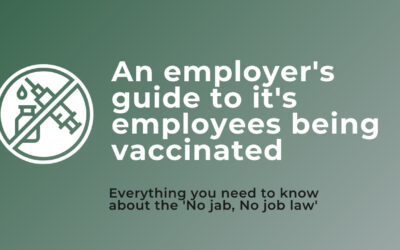REINSTATED FOR FURLOUGH – NOW WHAT?
NOTE: Employers receive no benefit for having reemployed someone. They are still obliged to end the employment for a fair reason, following a fair process.
How to dismiss an employee
There are only 5 potentially fair reasons to dismiss an employee. Dismissal because an employee was reinstated for furlough is NOT a fair dismissal. Employees with over 2 years service can bring an unfair dismissal claim if they are dismissed for this reason. The ONLY 5 potentially fair reasons to dismiss an employee with over 2 years service are:
- Conduct
- Capability (including medical capability)
- Redundancy
- Illegality
- Some Other Substantial Reason
Generally an employee with less than 2 yeas service cannot bring an unfair dismissal claim and employers do not therefore need to dismiss for one of the 5 potentially fair reasons. (In some circumstances we advise that dismissing an employee with less than 2 years service should still be for one of the 5 reasons above.)
In terms of whether the employee has 2 years service, it may well be that there was sufficient break between the pre-covid dismissal and the reinstatement to break the service. We recommend that employers take advice on this point.
Redundancy dismissal
A business which has too many employees is usually able to rely on redundancy as a fair reason to dismiss. Employers must still use a fair process and should not base a redundancy on selecting reinstated employees who were furloughed.
Employers must pool all employees who carry out the same or similar work. They must consult and objectively score those employees. A generic redundancy process consists of:
- Business Case for redundancy setting out reasons and including provisional pools for selection;
- Announcement meeting with affected employees;
- Letter to employees putting them at risk of redundancy. Formal invitation to first group consultation to discuss the pools and employees’ ideas;
- Formal invitation to second group consultation to discuss feedback on employees’ proposals and scoring (if needed).
- Objective scoring carried out.
- Formal invitation to individual consultation meeting for lowest scored.
- Formal invitation to final consultation meeting wherein dismissal for reason of redundancy is confirmed.
NOTE: Employers may be able to avoid the above if the employees have less than 2 years service and there are no protected characteristics or acts to be concerned about.
What about redundancy pay?
Employees with over 2 years service are entitled to redundancy pay and this cannot be claimed back through the Coronavirus Job Retention Scheme. The redundancy pay will be between 0.5-1.5 weeks pay for each full year of employment, capped at £538 a week.
Watch out for the notice period rolling into another years continuous service, resulting in another year to be added to the redundancy calculations.
What about the notice pay?
Employees are entitled to receive 100% of their wage in their notice period and should keep the employee on furlough rather than pay them in lieu of the notice. Employers can then claim back up to 80% through the Coronavirus Job Retention Scheme.
Does the annual leave have to be paid?
Yes.
Annual leave continued to accrue during a period of furlough. Employers have to pay it in lieu unless it is used up before the employment ends. 4 months worth of annual leave for an employee with the statutory minimum entitlement is 9.5 days. 9.5 days extra PER EMPLOYEE!
There are two options available to employers to avoid paying a lump sum of accrued annual leave:
- Serve notice under Regulation 15 Working Time Regulations that the leave must be taken. Employers must serve double the notice of the period of leave. If an employee has accrued 9.5 days annual leave, they can service notice 19 days in advance that the following 9.5 days will be annual leave days.
- Rely on a contractual right to enforce unused holidays to be taken during the notice period.
Although annual leave has to be paid at 100%, both of the above options mean that an employer can claim back up to 80% if the employee is still furloughed. This cannot be claimed back if the holiday pay is paid as a lump sum.
Was Martin Lewis right?
For employees? Probably.
For employers? Absolutely not.
The decision to reinstate employees is now causing businesses a headache. Businesses have to ensure that dismissals are fair. It is costing time, HR support and most importantly: notice pay, holiday pay and redundancy pay.
Luckily we advised our clients against reinstating anyone. Even if Martin Lewis thinks this was morally wrong – our clients have been able to protect the future viability of their business and keep more people in employment for longer. We think that’s a better moral result!

You might also like…
An update to family friendly rights
Flexible working became a priority during the pandemic, the necessity to work from home to help prevent the spread of coronavirus was a preventative measure but it demonstrated the fact that we do have the ability to work remotely and flexibly.
Although we are seeing employers trying to persuade staff back to the office because of the social, knowledge sharing and team building benefits the government have implemented some significant changes to the flexible working practices.
A change to flexible working requests and a right to ask for predicability over hours
Flexible working became a priority during the pandemic, the necessity to work from home to help prevent the spread of coronavirus was a preventative measure but it demonstrated the fact that we do have the ability to work remotely and flexibly.
Although we are seeing employers trying to persuade staff back to the office because of the social, knowledge sharing and team building benefits the government have implemented some significant changes to the flexible working practices.
Carer’s Leave – a new right for employees
The Carer's Leave Regulations 2024 provide employees with the right to take leave to care for a dependant who needs long-term care







